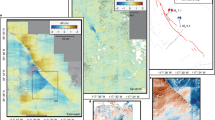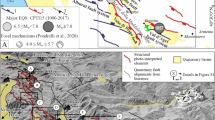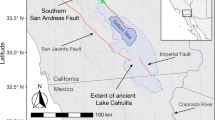Abstract
Recent widespread seismicity in Oklahoma is attributed to the reactivation of pre-existing, critically stressed and seismically unstable faults due to decades of wastewater injection. However, the structure and properties of the reactivated faults remain concealed by the sedimentary cover. Here, we explore the major ingredients needed to induce earthquakes in Oklahoma by characterizing basement faults in the field, in seismic surveys and via rock-mechanics experiments. Outcrop and satellite mapping reveal widespread fault and fracture systems with trends that display a marked similarity to the trends of recent earthquake lineaments. Our three-dimensional seismic analyses show steeply dipping basement-rooted faults that penetrate the overlying sedimentary sequences, representing pathways for wastewater migration. Experimental stability analysis indicates that Oklahoma’s basement rocks become seismically unstable at conditions relevant to the dominant hypocentral depths of the recent earthquakes. These analyses demonstrate that the geometry, structure and mechanical stability of Oklahoma’s basement make it critically susceptible to seismic reactivation.
This is a preview of subscription content, access via your institution
Access options
Access Nature and 54 other Nature Portfolio journals
Get Nature+, our best-value online-access subscription
$29.99 / 30 days
cancel any time
Subscribe to this journal
Receive 12 print issues and online access
$259.00 per year
only $21.58 per issue
Buy this article
- Purchase on Springer Link
- Instant access to full article PDF
Prices may be subject to local taxes which are calculated during checkout




Similar content being viewed by others
Data availability
All data and materials that support the findings of this study can be made available, in some form, to any researcher for purposes of reproducing or extending the analysis upon request to the corresponding author. The 3D seismic data from Osage County are publicly available through Osage Nation. Oklahoma Geological Survey data products can be found at www.ou.edu/ogs. Field mapping data can be provided upon request by contacting the corresponding author. Laboratory data appearing in Supplementary Figs. 4 and 6 acquired during experiments at the US Geological Survey in Menlo Park, California, and the friction data used in this study can be obtained from https://doi.org/10.5066/P9AJWOZD.
References
Ellsworth, W. L. Injection-induced earthquakes. Science 341, 1225942 (2013).
Keranen, K. M., Weingarten, M., Abers, G. A., Bekins, B. A. & Ge, S. Sharp increase in central Oklahoma seismicity since 2008 induced by massive wastewater injection. Science 345, 448–451 (2014).
Walsh, F. R. III & Zoback, M. D. Oklahoma’s recent earthquakes and saltwater disposal. Sci. Adv. 1, e1500195 (2015).
Schultz, R., Wang, R., Gu, Y. J., Haug, K. & Atkinson, G. A seismological overview of the induced earthquakes in the Duvernay play near Fox Creek, Alberta. J. Geophys. Res. Solid Earth 122, 492–505 (2017).
Chen, X. et al. The Pawnee earthquake as a result of the interplay among injection, faults and foreshocks. Sci. Rep. 7, 4945 (2017).
Goebel, T. H. W., Weingarten, M., Chen, X., Haffener, J. & Brodsky, E. E. The 2016 M w 5.1 Fairview, Oklahoma earthquakes: evidence for long-range poroelastic triggering at >40 km from fluid disposal wells. Earth Planet. Sci. Lett. 472, 50–61 (2017).
McGarr, A. & Barbour, A. J. Wastewater disposal and the earthquake sequences during 2016 near Fairview, Pawnee, and Cushing, Oklahoma. Geophys. Res. Lett. 44, 9330–9336 (2017).
Blanpied, M. L., Lockner, D. A. & Byerlee, J. D. Fault stability inferred from granite sliding experiments at hydrothermal conditions. Geophys. Res. Lett. 18, 609–612 (1991).
Bickford, M. E., Van Schmus, W. R., Karlstrom, K. E., Mueller, P. A. & Kamenov, G. D. Mesoproterozoic-trans-Laurentian magmatism: a synthesis of continent-wide age distributions, new SIMS U–Pb ages, zircon saturation temperatures, and Hf and Nd isotopic compositions. Precambrian Res. 265, 286–312 (2015).
Lidiak, E. G., Denison, R. E. & Stern, R. J. Cambrian (?) Mill Creek diabase dike swarm, eastern Arbuckles: a glimpse of Cambrian rifting in the Southern Oklahoma Aulacogen. Okla. Geol. Surv. Guideb. 38, 105–122 (2014).
Denison, R. E. Basement Rocks in Northeastern Oklahoma Circular 84 (Oklahoma Geological Survey, The University of Oklahoma Printing Services, 1981).
Denison, R. E., Lidiak, E. G., Bickford, M. E. & Kisvarsanyi, E. B. Geology and Geochronology of Precambrian Rocks in the Central Interior Region of the United States Professional Paper 1241-C (US Geological Survey, 1984).
Shah, A. K. & Keller, G. R. Geologic influence on induced seismicity: constraints from potential field data in Oklahoma. Geophys. Res. Lett. 44, 152–161 (2017).
Cannon, W. F. Closing of the Midcontinent Rift—a far-field effect of Grenvillian compression. Geology 22, 155–158 (1994).
Brewer, J. A., Good, R., Oliver, J. E., Brown, L. D. & Kaufman, S. COCORP profiling across the Southern Oklahoma aulacogen: overthrusting of the Wichita Mountains and compression within the Anadarko Basin. Geology 11, 109–114 (1983).
Powers, S. Age of the folding of the Oklahoma mountains—the Ouachita, Arbuckle, and Wichita mountains of Oklahoma and the Llano-Burnet and Marathon uplifts of Texas. Geol. Soc. Am. Bull. 39, 1031–1071 (1928).
Keller, G. R. & Stephenson, R. A. The Southern Oklahoma and Dniepr-Donets aulacogens: a comparative analysis. Geol. Soc. Am. Mem. 200, 127–143 (2007).
Denison, R. E. Significance of air-photograph linears in the basement rocks of the Arbuckle Mountains. In Structural Styles in the Southern Midcontinent, 1992 Symposium (ed. Johnson, K. S.) 119–131 (Oklahoma Geological Survey, 1995).
Barton, N. & Choubey, V. The shear strength of rock joints in theory and practice. Rock. Mech. 10, 1–54 (1977).
Martin, C. D. & Stimpson, B. The effect of sample disturbance on laboratory properties of Lac du Bonnet granite. Can. Geotech. J. 31, 692–702 (1994).
Segall, P. & Pollard, D. D. Nucleation and growth of strike slip faults in granite. J. Geophys. Res. Solid Earth 88, 555–568 (1983).
Barton, C. A. & Zoback, M. D. Self-similar distribution and properties of macroscopic fractures at depth in crystalline rock in the Cajon Pass scientific drill hole. J. Geophys. Res. 97, 5181–5200 (1992).
Sagy, A., Reches, Z. E. & Roman, I. Dynamic fracturing: field and experimental observations. J. Struct. Geol. 23, 1223–1239 (2001).
Fielding, E. J., Sangha, S. S., Bekaert, D. P., Samsonov, S. V. & Chang, J. C. Surface deformation of north-central Oklahoma related to the 2016 M w 5.8 Pawnee earthquake from SAR interferometry time series. Seismol. Res. Lett. 88, 971–982 (2017).
Elebiju, O. O., Matson, S., Keller, G. R. & Marfurt, K. J. Integrated geophysical studies of the basement structures, the Mississippi chert, and the Arbuckle Group of Osage County region, Oklahoma. Am. Assoc. Pet. Geol. Bull. 95, 371–393 (2011).
McGarr, A. & Barbour, A. J. Injection-induced moment release can also be aseismic. Geophys. Res. Lett. 45, 5344–5351 (2018).
Moore, D. E. & Lockner, D. A. Frictional strengths of talc‐serpentine and talc‐quartz mixtures. J. Geophys. Res. Solid Earth 116, B01403 (2011).
Harrison, W. E., Luza, K. V., Prater, M. L., Cheung, P. K. & Ruscetta, C. A. Geothermal Resource Assessment in Oklahoma No. DOE/ID/12079-71-Vol. 1/ESL-98-Vol. 1/CONF-820491 1–12 (Earth Science Laboratory, University of Utah Research Institute, 1982).
Dieterich, J. H. Modeling of rock friction 1. Experimental results and constitutive equations. J. Geophys. Res. 84, 2161–2168 (1979).
Marone, C. Laboratory-derived friction laws and their application to seismic faulting. Annu. Rev. Earth Planet. Sci. 26, 643–696 (1998).
Ikari, M. J., Marone, C. & Saffer, D. M. On the relation between fault strength and frictional stability. Geology 39, 83–86 (2011).
Nelson, P. H., Gianoutsos, N. J. & Drake, R. M. Underpressure in Mesozoic and Paleozoic rock units in the Midcontinent of the United States. Am. Assoc. Pet. Geol. Bull. 99, 1861–1892 (2015).
Blanpied, M. L., Tullis, T. E. & Weeks, J. D. Effects of slip, slip rate, and shear heating on the friction of granite. J. Geophys. Res. 103, 489–511 (1998).
Keranen, K. M., Savage, H. M., Abers, G. A. & Cochran, E. S. Potentially induced earthquakes in Oklahoma, USA: links between wastewater injection and the 2011 M w 5.7 earthquake sequence. Geology 41, 699–702 (2013).
Hurd, O. & Zoback, M. D. Regional stress orientations and slip compatibility of earthquake focal planes in the New Madrid seismic zone. Seismol. Res. Lett. 83, 672–679 (2012).
Reches, Z. Analysis of faulting in three-dimensional strain field. Tectonophysics 47, 109–129 (1978).
Heesakkers, V., Murphy, S., Lockner, D. A. & Reches, Z. Earthquake rupture at focal depth, part II: mechanics of the 2004 M 2.2 earthquake along the Pretorius Fault, TauTona Mine, South Africa. Pure Appl. Geophys. 168, 2427–2449 (2011).
Zoback, M. D. & Zoback, M. L. in Neotectonics of North America (eds Slemmons, D. B., et al.) 339–366 (Geological Society of America, 1991).
Walsh, F. R. III & Zoback, M. D. Probabilistic assessment of potential fault slip related to injection-induced earthquakes: application to north-central Oklahoma, USA. Geology 44, 991–994 (2016).
Barbour, A. J., Norbeck, J. H. & Rubinstein, J. L. The effects of varying injection rates in Osage County, Oklahoma, on the 2016 M w 5.8 Pawnee earthquake. Seismol. Res. Lett. 88, 1040–1053 (2017).
Marsh, S. & Holland, A. Comprehensive Fault Database and Interpretive Fault Map of Oklahoma Open-File Report OF2-2016 (Oklahoma Geological Survey, 2016).
Qi, W. Stress Analysis of Recent Earthquakes in Oklahoma. MSc thesis, University of Oklahoma (2016).
Alt, R. C. & Zoback, M. D. In situ stress and active faulting in Oklahoma. Bull. Seismol. Soc. Am. 107, 216–228 (2016).
Verberne, B. A., Niemeijer, A. R., De Bresser, J. H. P. & Spiers, C. J. Mechanical behavior and microstructure of simulated calcite fault gouge sheared at 20–600 °C: implications for natural faults in limestones. J. Geophys. Res. Solid Earth 120, 8169–8196 (2015).
Kanamori, H. Magnitude scale and quantification of earthquakes. Tectonophysics 93, 185–199 (1983).
Chopra, S. & Marfurt, K. J. Seismic Attributes for Prospect Identification and Reservoir Characterization (Society of Exploration Geophysicists, 2007).
Kroll, K. A., Cochran, E. S. & Murray, K. E. Poroelastic properties of the Arbuckle Group in Oklahoma derived from well fluid level response to the 3 September 2016 M w 5.8 Pawnee and 7 November 2016 M w 5.0 Cushing earthquakes. Seismol. Res. Lett. 88, 963–970 (2017).
Schoenball, M. & Ellsworth, W. L. Waveform‐relocated earthquake catalog for Oklahoma and southern Kansas illuminates the regional fault network. Seismol. Res. Lett. 88, 1252–1258 (2017).
Waldhauser, F. & Ellsworth, W. L. A double-difference earthquake location algorithm: method and application to the northern Hayward fault. Calif. Bull. Seismol. Soc. Am. 90, 1353–1368 (2000).
Ruina, A. Slip instability and state variable friction laws. J. Geophys. Res. 88, 10359–10370 (1983).
Acknowledgements
We acknowledge the USGS Induced Seismicity Project for providing financial support and laboratory expertise/time to conduct the experiments presented in this manuscript. We thank N. Beeler and A. Barbour for their helpful reviews. We thank Osage Nation and SpyGlass Energy, LLC, for providing the seismic data used in this study. We also thank the Oklahoma Geological Survey for providing earthquake and focal mechanism data.
Author information
Authors and Affiliations
Contributions
F.K., D.A.L., Z.R. and B.M.C. wrote the manuscript. F.K. and C.S.J. performed satellite fracture mapping. F.K., C.S.J., Z.R. and B.M.C. completed the fieldwork. J.C.C. assisted with earthquake relocation and epicentre-cluster lineament mapping. F.K. and K.J.M. completed the 3D seismic analysis. C.B.M., D.A.L., Z.R. and B.M.C. designed, performed, and analysed the friction experiments.
Corresponding author
Ethics declarations
Competing interests
The authors declare no competing interests.
Additional information
Publisher’s note Springer Nature remains neutral with regard to jurisdictional claims in published maps and institutional affiliations.
Supplementary information
Supplementary Information
Supplementary figures and tables.
Rights and permissions
About this article
Cite this article
Kolawole, F., Johnston, C.S., Morgan, C.B. et al. The susceptibility of Oklahoma’s basement to seismic reactivation. Nat. Geosci. 12, 839–844 (2019). https://doi.org/10.1038/s41561-019-0440-5
Received:
Accepted:
Published:
Issue Date:
DOI: https://doi.org/10.1038/s41561-019-0440-5
This article is cited by
-
Laboratory Shear Behavior of Tensile- and Shear-Induced Fractures in Sandstone: Insights from Acoustic Emission
Rock Mechanics and Rock Engineering (2024)
-
High seismic velocity structures control moderate to strong induced earthquake behaviors by shale gas development
Communications Earth & Environment (2023)
-
Pore morphology effect on elastic and fluid flow properties in Bakken formation using rock physics modeling
Geomechanics and Geophysics for Geo-Energy and Geo-Resources (2022)
-
Mechanical zonation of rock properties and the development of fluid migration pathways: implications for enhanced geothermal systems in sedimentary-hosted geothermal reservoirs
Geothermal Energy (2021)
-
Growing seismicity in the Sichuan Basin and its association with industrial activities
Science China Earth Sciences (2020)



